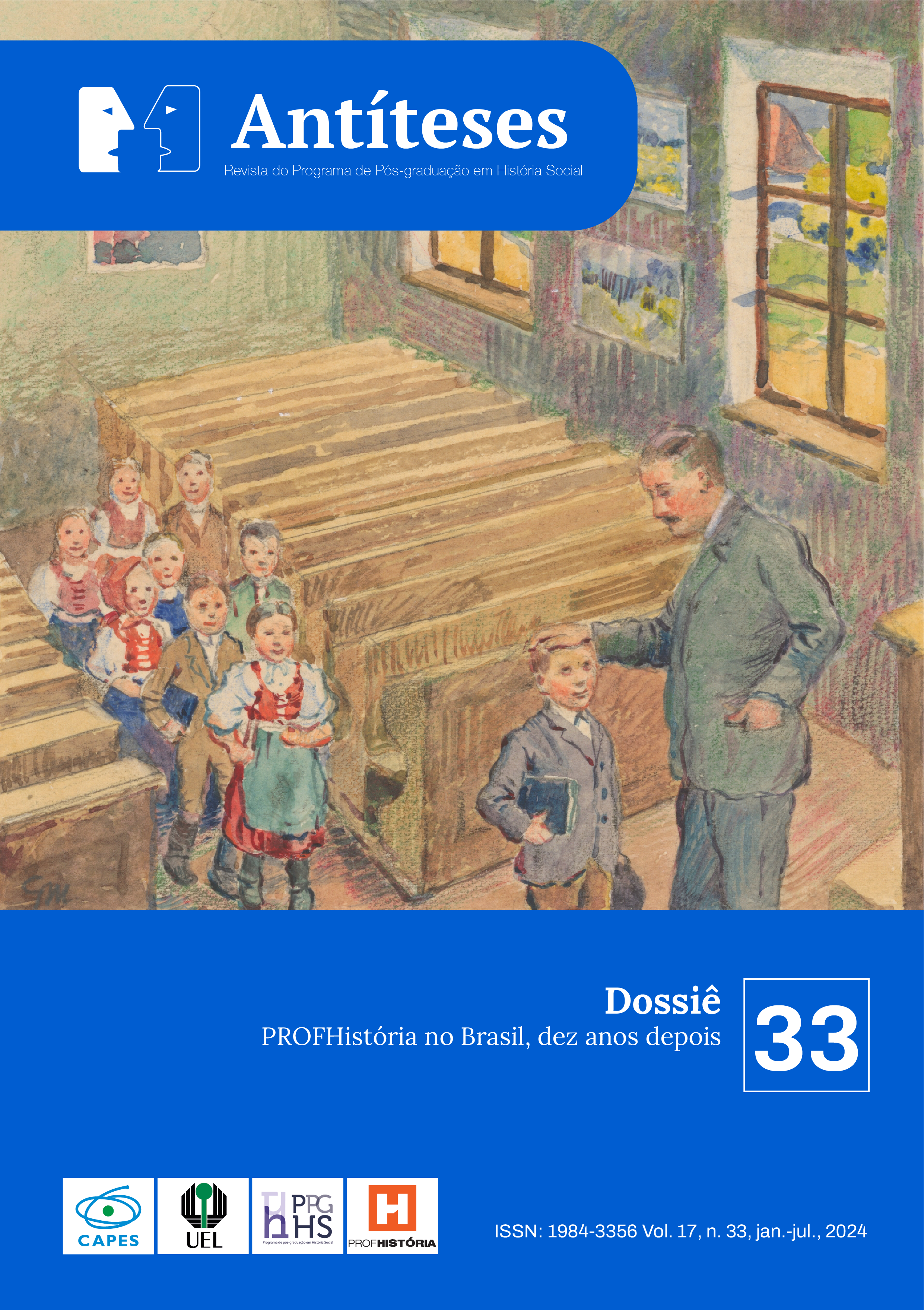The IqtÄ' System in Egypt or the Backbone of the Mamluk Sultanate
Subduing the Last Crusaders, Resisting the Mongols, Calming the Bedouins (7th century of the Hegira / 13th century of the Common Era)
DOI:
https://doi.org/10.5433/1984-3356.2024v17n33p384-423Palabras clave:
Mamluk, Egypt, Crusades, IqtÄ', Ibn Abd al ZÄhir, Baybars al-MansÅ«rÄ«Resumen
There should be two concerns implied when a symmetrical history of the Crusades is put forward. First is to expressively study the Muslim document set and secondly the relationship of the historical agents with the environment is to be considered. In this paper we discuss the iqtÄ' system and its simultaneous role in maintaining power balance and in ensuring effective exploitation of natural resources within the Mamluk Sultanate. We have selected the narratives of two Mamluk chroniclers to support our discussion. These narratives are about sultan QalÄwÅ«n undertaking efforts, in 682/1283, to open an irrigation canal in al-Buhayra in the Nile River Delta. This discussion aims to criticize the mistake of considering the Sultanate incapable of dealing with problems such as droughts and famines. In addition, it examines how the sultans coped with their internal political problems, like the nomadic opposition and other dissidence. These challenges coexisted at the same time that confronting the last enclaves Crusaders in Syria and responding the Mongol growing threat was needed.
Descargas
Citas
AHARONI, Reuven. Bedouin and Mamluks in Egypt - co-existence in a state of duality. In: WINTER, Michael (ed.) & LEVANONI, Amalia (ed.). The Mamluks in Egyptian and Syrian Politics and Society. Leiden: Brill, 2004, p.407-434.
AMITAI, Reuven. Between the Slave Trade and Diplomacy: Some Aspects of Early Mamluk Policy in the Eastern Mediterranean and the Black Sea. In: AMITAI, Reuven (ed.) & CLUSE, Christoph (ed.). Slavery and the Slave Trade in the Eastern Mediterranean. Turnhout: Brepols, 2017, p. 401-422.
BANKOFF, G. Cultures of Disaster, Cultures of Coping. Hazard as a Frequent Life Experience in the Philippines. In: MAUCH, Ch. (ed.) et alii. Natural Disasters, Cultural Responses. Case Studies toward a Global Environmental History. Lanham: The Rowman & Littlefield Publishing Group, 2009, p. 265-284.
____________. Cultures of Disaster: Society and Natural Hazard in the Philippines. London: Routledge 2003.
BAVEL, Bas van; CURTIS, Daniel, R.; DIJKMAN, Jessica; HANNAFORD, Matthew; KEYZER, Maïka; ONACKER, Aline van; SOENS, Tim. Disasters and History: the vulnerability and resilience of past societies. Cambridge: Cambridge University Press, 2020.
BAYBARS AL-MANSŪRĪ. Zubdat al-Fikra FÄ« TÄ'rÄ«kh al-Hijra. In: COOK, David (transl.). Chronicles of QalÄwÅ«n and his Son Al-Ashraf Khalil. Abingdon: Routledge, 2020.
BERGER, Simon. Mingghan et Tamma: l'administration nomade des frontières dans l'Empire Mongol au XIIIe siècle. In : SOCIÉTÉ DES HISTORIENS MÉDIÉVISTES DE L'Enseignement SUPÉRIEUR PUBLIC. Frontières Sociales au Moyen Âge. Paris : Éditions de la Sorbonne, 2021, p.177-193.
BORA, Fozia. Writing History in the Medieval Islamic World: the value of chronicles as archives. London: I.B.Tauris, 2019.
BREASTED, James Henry. Ancient Records of Egypt. Vols I-IV. Chicago: The University of Chicago Press, 1906.
CHALYAN-DAFFNER, Kristine. Natural Disasters in Mamlūk Egypt (1250-1517): perceptions, interpretations, and human responses. (PhD Thesis submitted to the Philosophical Faculty Department of Languages and Cultures of the Near East for degree of Doctor of Philosophy). Heidelberg: Ruperto Carola Heidelberg University / Cluster of e Excellence Asia and Europe in a Global Context, 2013.
CHAPOUTOT-REMADI, Mounira. Une Grand Crise à la Fin du XIIIe Siècle en Egypt. In: JESHO, no. 24, 1983, p. 217-245.
CONERMANN, Stephan (ed.). Mamluk Historiography Revisited: narratological perspectives. Göttingen: Bonn University Press, 2018.
DENOIX, Sylvie (dir.) & RENEL, Hélène (dir.). Atlas des Mondes Musulmans Médiévaux. Paris: CNRS Editions, 2022.
ELLENBLUM, Ronnie. Crusader Castles and Modern Histories. Cambridge:
Cambridge University Press, 2007.
____________________. The Collapse of the Eastern Mediterranean: climate change and the decline of the East (950-1072). Cambridge: Cambridge University Press, 2012.
FAVEREAU, Marie. La Horde D'Or et le Sultanat Mamelouk : naissance d'une alliance. Le Caire : Institut Français d'Arquéologie Orientale, 2018.
FLORI, Jean. La Guerre Sainte : la formation de l'idée de Croisade dans l'Occident chrétien. Paris : Aubier, 2009.
FRENKEL, Yehoshua. The Mamluk Sultanate and its Neighbours: economic, social and cultural entanglements. In: AMITAI, Reuven (ed.) & CONERMANN, Stephan (ed.). The Mamluk Sultanate from the Perspective of Regional and World History. Göttingen: Vandenhoeck & Ruprecht, 2019, p.39-60.
__________________. Mapping the Mamluk Sultanate. In: CONERMANN, Stephan, (ed.). History and Society during the MamlÅ«k Period (1250-1517). Studies of the Annemarie Schimmel Research College. Göttingen: Vandenhoeck & Ruprecht, 2014, p. 37-60.
HEIDEMANN, Stefan. Arab Nomads and the Seljūq Military. In: LEDER, Stefan (ed.) & STRECK, Bernard (ed.). Shifts and Drifts in Nomad-Sedentary Relations. Wiesbaden: Reichert, 2005, p.289-305.
IBN 'ABD AL-ZAHIR. Tashrif al-Ayyam Wa-L-'Usur Fi Sirat Al-Malik Al-Mansur. In: COOK, David (transl.). Chronicles of QalÄwÅ«n and his Son Al-Ashraf Khalil. Abingdon: Routledge, 2020.
MACKINNON, Danny; DERICKSON, Kate Driscoll. From Resilience to Resourcefulness: a critique of resilience policy and activism. In: Progress in Human Geography, No. 37, 2012, p. 253-270.
MAZOR, Amir. The Early Experience of the Mamluk in the First Period of the Mamluk Sultanate (1250-1282). In: AMITAI, Reuven & CLUSE, Christoph. Slavery and the Slave Trade in the Eastern Mediterranean (c.1000-1500 CE). Turnhout: Brepols, 2017, p. 213-234.
MORTON, Nicholas. The Crusader States & Their Neighbours: a military history (1099-1187). Oxford: Oxford University Press, 2020.
PREISER-KAPELLER, J. A Climate for Crusades? Weather, climate, and armed pilgrimage to the Holy Land (11th-14th century). Pre-print, German version to be published in: Karfunkel - Zeitschrift für erlebbare Geschichte. Combat-Sonderheft 10, 2013 (in print; Communicating Science to the Public), p.1-11.
RAPHAEL, Sarah Kate. Climate and Political Climate: environmental disasters in the Medieval Levant. Leiden: Brill, 2013.
RAPOPORT, Yossef. Invisible Peasants, Marauding Nomads: taxation, tribalism, and rebeleion in Mamluk Egypt. In: Mamlūk Studies Review, V. 8, No. 2, 2004, p.1-22.
_________________. Rural Economy and Tribal Society in Islamic Egypt: a study of al-NÄbulusÄ«'s Villages of the Fayyum. Turnhout: Brepols, 2018.
RAPOPORT, Yossef & SHAHAR, Ido. Irrigation in the Medieval Islamic Fayyum: Local Control in a Large-Scale Hydraulic System. In: Journal of the Economic and Social History of the Orient, No. 55, 2012, p. 1-31.
RASHIDIAN, Elnaz. The Resilience Concept in Archaeology; a critical consideration. In: Academia Letters, 2021, p. 1-6.
RICHARDS, Donald. A Mamluk Amir's Mamluk History: Baybars al-Manṣūrī's Zubdat al-Fikra. In: KENNEDY, Hugh (ed.). The Historiography of Islamic Egypt (c. 950-1800). Leiden: Brill, 2001, p. 37-44.
_________________. Baybars al-Mansūrī. In: DUNPHY, Graeme. The Encyclopedia of the Medieval Chronicle, V. 1. Leiden: Brill, 2010, p. 149.
SALEH, Abdel Hamid. Quelques Remarques sur les Bédouins d'Égypte au Moyen Age. In: Studia Islamica, No. 48, 1978, p.45-70.
SATO, Tsugitaka. Irrigation in Rural Egypt from the 12th to the 14th centuries: especially in case of the irrigation in Fayyūm Province. In: Orient, vol.8, 1972, p.81-92.
______________. State and Rural Society in Medieval Islam: sultans, muqta's and fallÄhÅ«n. Leiden: Brill, 1997.
SUBRAHMANYAM, Sanjay. Aux Origines de L'histoire Globale. Paris : Collège de France / Fayard, 2014.
TUCKER, William. Environmental Hazards, Natural Disasters, Economic Loss, and Mortality in Mamluk Syria. In: MSR, no. 3, 2003, p.109-128.
USÂMA IBN MUNQIDH. Kitâb al-I'tbâr. In: MIQUEL, André (trad.). Des Enseignements de La Vie. Paris: Imprimerie Nationale, 1983.
WESTERMANN, W. L. The Development of the Irrigation System of Egypt. In: Classical Philology. Vol. 14, No. 2, 1919, p. 158-164.
YUDKEVICH, Jenia. The Nature and Role of the Slave Traders in the Eastern Mediterranean during the Third Reign of Sultan al-Nāsir Muhammad B. Qalāwūn (1310-41 CE). In: AMITAI, Reuven (ed.) & CLUSE, Christoph (ed.). Slavery and the Slave Trade in the Eastern Mediterranean. Turnhout: Brepols, 2017, p. 423-436.
Descargas
Publicado
Cómo citar
Número
Sección
Licencia
Derechos de autor 2024 Bruno Tadeu Salles

Esta obra está bajo una licencia internacional Creative Commons Atribución 4.0.
A Revista Antíteses adota a Licença Creative Commons Attribution 4.0 International, portanto, os direitos autorais relativos aos artigos publicados são do(s) autor (es), que cedem à Revista Antíteses o direito de exclusividade de primeira publicação.
Sob essa licença é possível: Compartilhar - copiar e redistribuir o material em qualquer suporte ou formato. Adaptar - remixar, transformar, e criar a partir do material, atribuindo o devido crédito.
https://creativecommons.org/licenses/by/4.0/












